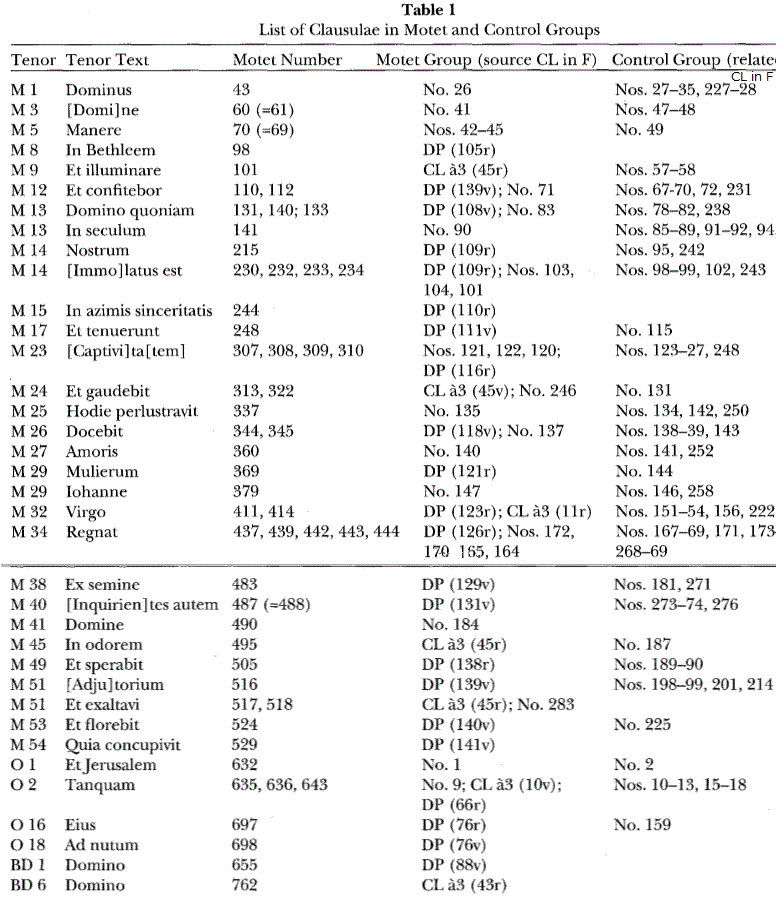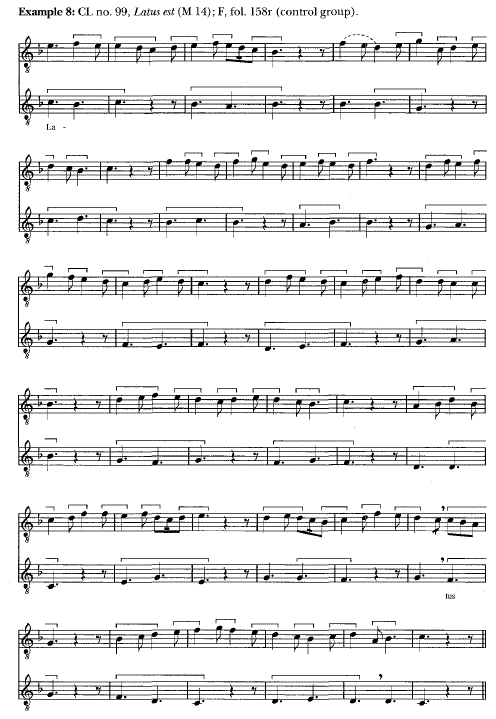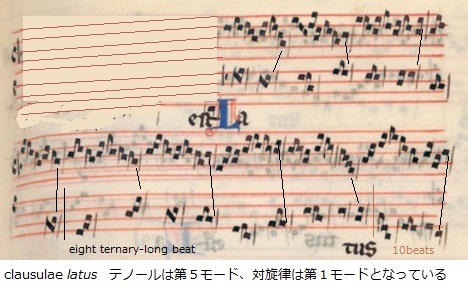| The Selection of Clausula
Sources for ThirteenthCentury Motets: Some Practical Considerations and Aesthetic Implications 抜粋2 |
●The Selection of Clausula Sources for ThirteenthCentury
Motets: Some Practical Considerations and Aesthetic Implications By
Susan A. Kidwell  ●よいclausulaではあるが、motet化はされなかった例 Clausula no. 99, representative of the control group, appears below . This setting of (immo)Latus est from the Easter Alleluia Pascha nostrum (M 14) combines a first-mode duplum with a fifth-mode tenor. Its overall length of seventy-four ternary-long beats could have provided a composer with enough material to support a meaningful added text. However, it has other attributes that are atypical of motet sources. It has a modal purity level of 83.1 %, which exceeds the norms for both the motet and control groups. The phrase organization of this Latus est clausula is also quite regular: it has eight phrases of eight ternary-long beats before a phrase of ten beats leading to an organal conclusion . It should also be noted that the tenor and duplum cadence together with a full (or masculine) ending for all nine phrases. This composition may well have been considered a good clausula in its time. In fact, its regularity and periodicity may reflect the influence of Perotinian style, and Perotin was regarded by Anonymous IV as the best composer of discant (Yudkin 1985: 39). A texted version of this model could have featured regular declamation of thirteen-syllable lines as prefigured by modal purity and uniform phrase lengths, in which case the resulting motet could have approximated a conductus. Yet while many attributes found in this Latus est clausula typify the control group, few thirteenth-century motets exhibit such regularity. (同書p17より改変)   magnus liber パート1 p290 あまりにその規則性、周期性がきちんとしているために、またモード性も強い(83%が第一モード)ために、clausulaとしてはよい曲であったが、motetに要求された不規則性、”遊び”の要素が少なく、condutsusに近い状況となったため、motet化されなかった。 ●clausulaがmotet化するための条件(同書p23〜) It appears that the source clausulae for early Latin two-voice motets distinguish themselves from the larger repertory of Notre Dame clausulae in terms of their treatment of modal purity, phrasing, and cadential patterns. These differences suggest that for the purposes of texting, thirteenth-century composers did not view all clausulae as equal. Instead, it seems that a variety of practical and aesthetic concerns influenced their selection process. In general, clausulae that were too brief, were composed of very short phrases or one long phrase, had too many isolated single notes or rests, had uniform cadences, or had an excessive amount of modal fracturing rarely served as sources for early Latin motets. Apparently, these features were impractical and undesirable for texting. Nor does it appear that composers went out of their way to select clausulae that would be easy to sight read when converted into cum littera notation;very likely, the preference for internal variety in the rhythmic declamation would require prior knowledge of the clausula source's sine littera rhythmic notation. In addition to these practical matters, stylistic features of the motet source group point to an aesthetic preference for variety, contrast, and irregularities of design. Since these features were more pronounced in the motet sources than in the controlgroup clausulae, it appears that "irregularities" in the early Latin motet do not automatically result from texting clausulae, but instead reflect artistic choice. Latin motets have irregularly patterned text declamation, because their texts were underlaid syllabically according to the irregular rhythms of their parent clausulae.This approach to text underlay allowed composers to emphasize selected units of text and therefore to communicate the meaning of their texts more effectively.However, while irregular declamation typifies early Latin motets, regular declamation became characteristic of other subgenres of motets. |